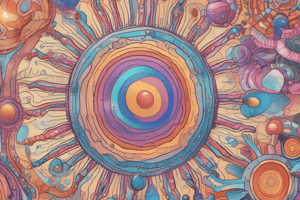Podcast
Questions and Answers
What type of fluid makes up 2/3 of the body's total fluid content?
What type of fluid makes up 2/3 of the body's total fluid content?
- Intracellular fluid (correct)
- Extracellular fluid
- Interstitial fluid
- Plasma fluid
Which of the following is NOT a characteristic of cells?
Which of the following is NOT a characteristic of cells?
- Have the ability to reproduce
- Produce waste byproducts
- Conduct electrical impulses (correct)
- Utilize oxygen and macromolecules
What is the primary role of homeostasis in the human body?
What is the primary role of homeostasis in the human body?
- To increase the production of metabolic waste
- To facilitate reproduction of cells
- To maintain nearly constant conditions in the internal environment (correct)
- To enhance the growth of microorganisms
Which system is responsible for removing carbon dioxide from the body?
Which system is responsible for removing carbon dioxide from the body?
What primarily regulates the concentration of substances in the human body?
What primarily regulates the concentration of substances in the human body?
Which type of fluid is found in blood plasma and is considered part of the external environment?
Which type of fluid is found in blood plasma and is considered part of the external environment?
What is the function of the liver in the body's waste management?
What is the function of the liver in the body's waste management?
Which macromolecule group is obtained primarily from food through the gastrointestinal system?
Which macromolecule group is obtained primarily from food through the gastrointestinal system?
What is the primary role of the sensory system in the nervous system?
What is the primary role of the sensory system in the nervous system?
Which component of the autonomic system is responsible for subconscious control?
Which component of the autonomic system is responsible for subconscious control?
How does hemoglobin respond when oxygen levels are low in the body?
How does hemoglobin respond when oxygen levels are low in the body?
Which system includes the spleen, thymus, and lymph nodes?
Which system includes the spleen, thymus, and lymph nodes?
What happens when blood pressure is high according to the baroreceptor system?
What happens when blood pressure is high according to the baroreceptor system?
What is the main function of the integumentary system?
What is the main function of the integumentary system?
Which of the following statements about carbon dioxide regulation is true?
Which of the following statements about carbon dioxide regulation is true?
Which system generates new beings?
Which system generates new beings?
Flashcards are hidden until you start studying
Study Notes
Overview of Physiology
- Physiology studies physical and chemical mechanisms underlying life.
- Human Physiology focuses on mechanisms specific to the human body.
- Pathophysiology examines dysfunctions within body systems relevant to clinical medicine.
Cells: The Basic Unit of Life
- Cells are essential living units in the body.
- Share common characteristics: utilization of O₂, macromolecules, energy production, chemical reaction by-products, and ability to reproduce.
- Microorganisms outnumber human cells, forming microbiota within the body.
Body Fluid Composition
- Adults are comprised of 50% - 70% fluid.
Intracellular Fluid
- Found inside cells including cytoplasm and vacuoles.
- Represents about two-thirds of body fluid.
- Contains potassium, magnesium, and phosphates.
Extracellular Fluid
- Located outside cells, mainly in blood plasma.
- Represents one-third of body fluid.
- Contains sodium, chloride, and bicarbonate, serving as the "internal environment."
- Responsible for carrying carbon dioxide and metabolic waste.
Homeostasis
- Homeostasis maintains constant internal conditions vital for body function.
- Organs and tissues contribute to the regulation of ion, nutrient, and waste levels.
- Control systems adapt to environmental variations, injuries, and diseases, albeit with potential long-term trade-off issues.
Nutrient Acquisition
- Oxygen sourced from the respiratory system.
- Macromolecules (carbohydrates, fatty acids, amino acids) derived from food via the gastrointestinal system.
Waste Removal Mechanisms
- Lungs excrete CO₂ during exhalation in exchange for O₂.
- Kidneys filter blood, producing urine to remove waste.
- Gastrointestinal system eliminates undigested food as feces.
- Liver detoxifies drugs and secretes waste through bile.
Regulation of Body Functions
Nervous System
- Sensory organs detect internal/external state.
- Central nervous system processes information and formulates responses.
- Motor system controls muscles and reflex actions.
- Autonomic system regulates internal organ functions subconsciously.
Endocrine System
- Secretes hormones into the bloodstream, influencing various body organs.
Protection Systems
Immune System
- Comprises spleen, thymus, lymph nodes, and white blood cells.
- Identifies and neutralizes harmful invaders.
Integumentary System
- Skin and appendages offering protection.
- Maintains thermoregulation, waste excretion, and sensory reception.
Reproductive System
- Facilitates generation of new life to replace losses.
Control Systems Within the Body
- Genetic systems manage intracellular and extracellular functions.
- Organs self-regulate or coordinate with other organs.
Oxygen Regulation
- Hemoglobin (Hgb) binds O₂ in the lungs for transport.
- O₂ release occurs when levels are low; retention happens at adequate levels.
Carbon Dioxide Regulation
- CO₂, a metabolic byproduct, poses risks at high levels.
- Increased CO₂ prompts rapid breathing to expel excess gas.
Blood Pressure Regulation
- Baroreceptor system serves as a pressure detection mechanism.
- Vasomotor system controls heart rate and vessel relaxation.
High Blood Pressure Response
- Increased baroreceptor stretch stimulates vasomotor center, reducing heart output and relaxing blood vessels to lower blood pressure.
Low Blood Pressure Response
- Decreased baroreceptor stretch deactivates vasomotor response, enhancing heart output and constricting vessels to elevate blood pressure.
Feedback Control System
- Feedback mechanisms continuously assess and adjust body functions based on prevailing conditions, maintaining homeostasis.
Studying That Suits You
Use AI to generate personalized quizzes and flashcards to suit your learning preferences.




